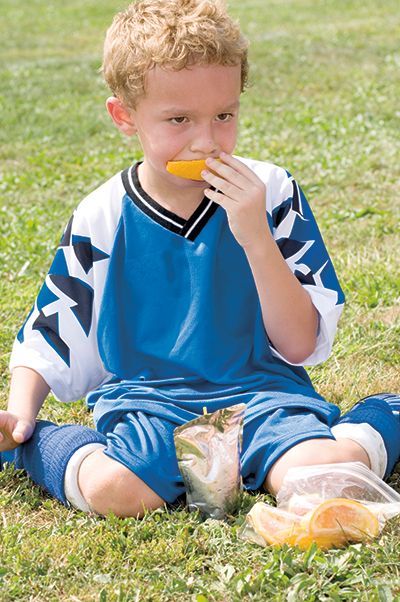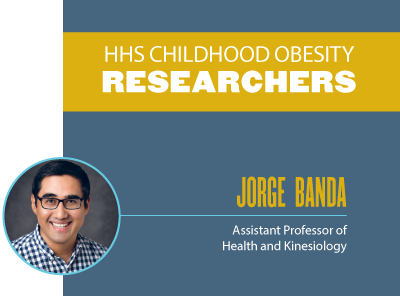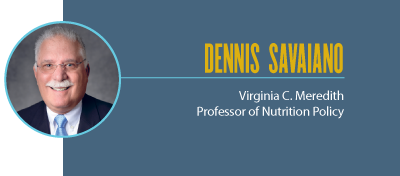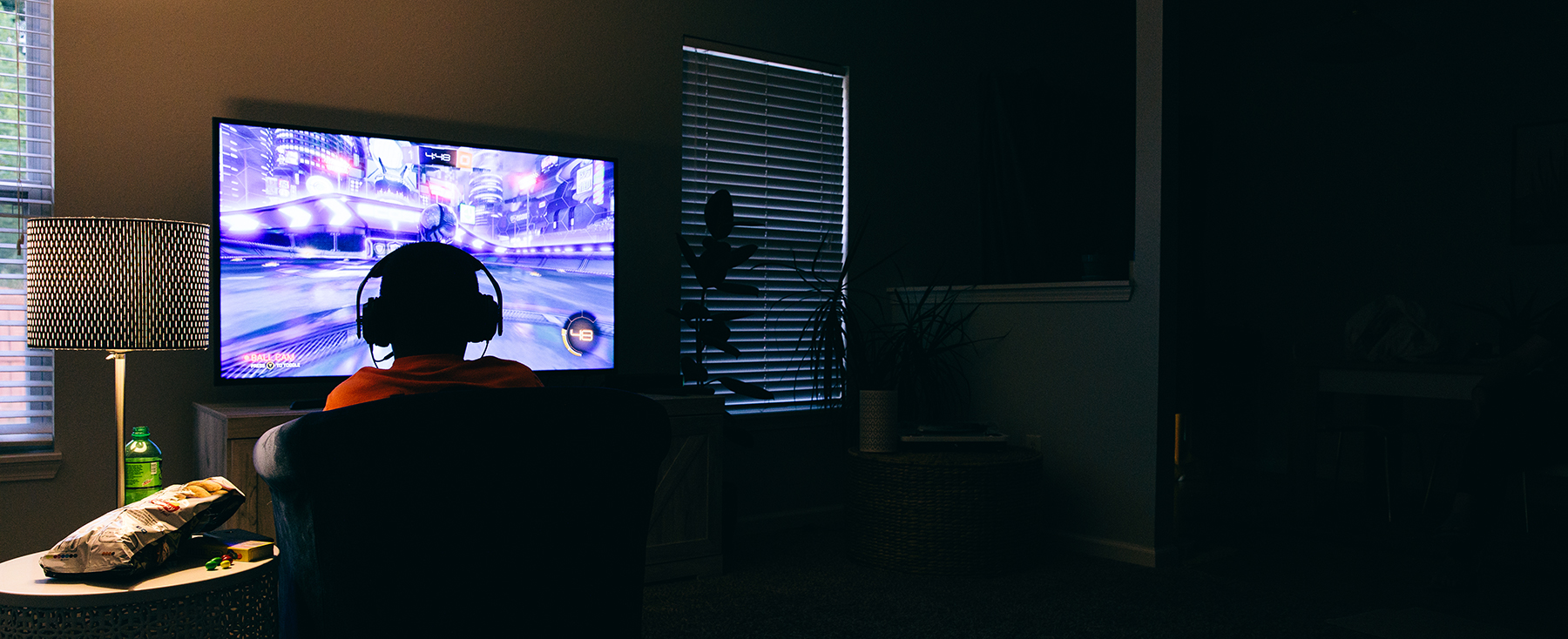Environment for Obesity
HHS Research Suggests Adjusting Culture, Policy and Habits to Prevent Childhood Obesity
Story by Brian Zink, Photo By Brian Powell
Obesity among children and adolescents in the United States is a complicated challenge for researchers, policymakers, the health profession and communities.
Untying the complex issues that drive and bind together childhood and adolescent obesity involves not only seeking answers through research but also finding ways to make changes to a society that has, in large part, evolved to create and perpetuate obesity.
“Most people would argue that obesity is a policy, systems and environment problem,” says Dennis Savaiano, Purdue’s Virginia C. Meredith Professor of Nutrition Policy. “A lot of the policies we have implemented in the past 50 years are the cause of that obesity, in my opinion. Why do we have an automobile culture? Why do our schools not have bike paths and walking paths? Nobody tried to design an obesogenic environment. That wasn’t the goal or the intent, but we have succeeded pretty well.”
The number of children tangled in the obesity web is staggering, and the implications are dire.
According to the U.S. Centers for Disease Control and Prevention (CDC), for those ages 2-19, obesity levels are at 18.5%, or nearly 14 million U.S. children and adolescents. And obese youths have a high likelihood of becoming obese adults. The National Survey of Children’s Health cites a study that found overweight 5-year-olds were four times more likely to be obese at age 14 than children with healthier weights, and carrying that weight into adolescence increases the chances of adulthood obesity.
If current trends continue, more than half of today’s children will be obese by age 35. Along with that obesity comes increased risk for Type 2 diabetes, heart disease, high blood pressure and asthma.
Be a sport
Jorge Banda, assistant professor of health and kinesiology, is going into the field to examine how youth team sports programs can be part of breaking the cycle of obesity. The focus of his research lab is three broad areas: increasing childhood physical activity; improving children’s eating behaviors; and preventing and treating childhood obesity.
“Can we use youth team sports programs to prevent and treat obesity in kids?” he asks. “My goal is to work with community organizations to create the best possible sports programs for the kids.”

Banda is partnering with youth sports programs in Lafayette and Indianapolis. Children ages 3-10 are fitted with accelerometers during practices to track their physical activity levels, and their snacks and drinks during practices are monitored.
Surprisingly, activity levels in some sports activities are not as high as people might think. Banda says previous research has shown students in school physical education programs spend only about 20% of their time being active, and in sports programs the activity level rises to just 30-40%.
“What we want to know is how physically active the kids are during their sports practices, and we want to know the quality of the snacks and beverages they get,” he says.
Coaches also play a key role in Banda’s work, since they are on the front lines of helping children develop a love not only of their sport, but also of physical activity in general.
“We want to understand the coaches’ previous experience and if they would be interested in taking part in a coach-training program we want to develop,” he says. “I want them to be the best possible coaches, to make sure kids have really great experiences so they want to continue to take part in sports or physical activity.”

Banda’s work with coaches is based in social psychology theory — encouraging interactions that promote a growth mindset among children that tells them they can improve, versus a fixed mindset that values inherent talent over work and improvement. And if you are what you eat, you also are what you think.
“Part of my long-term work is to help coaches interact with kids in a way that promotes that growth mindset so that kids believe if they work hard they can get better, have fun and be successful,” Banda says. “Kids with a growth mindset are willing to take on more challenges and are more likely to put forth effort to overcome setbacks. Kids with a fixed mindset don’t want to take on new challenges.”
Diabetes: The lurking danger
Nana Gletsu Miller, an associate professor of nutrition science, is researching a relatively recent phenomenon — a growing number of adolescents developing Type 2 diabetes. The disease typically is referred to as adult-onset diabetes, since it historically strikes older adults. Type 2 diabetes leads to further complications such as kidney damage leading to kidney failure and retinopathy, which is damage to the retina that results in vision impairment and even blindness.
“Because we have an epidemic of childhood obesity where children are not only overweight and obese, but moving into the severely obese category, we are starting to see Type 2 diabetes develop in kids for the first time ever,” Gletsu Miller says. “We need to learn a lot about it in terms of treatment and prevention.”
Gletsu Miller’s co-principal investigator on the project is Dr. Tamara Hannon, a pediatric endocrinologist at IU Health. The multidisciplinary team also includes Purdue researchers Banda; Cordelia Running, assistant professor of nutrition science; Wayne Campbell, professor of nutrition science; Fengqing Zhu, assistant professor of electrical and computer engineering; and Edward Delp, the Charles William Harrison Distinguished Professor of Electrical and Computer Engineering and professor of biomedical engineering.
The team wants to find out if diet can reverse or mitigate issues in adolescents who are prediabetic and thereby prevent the onset of full-blown Type 2 diabetes. The average age of the study participants is 14, and all are in the severely obese category. In the United States, 8% of girls and 5% of boys fall into this category.

“We believe that certain dietary habits promote Type 2 diabetes, which is why we are focusing on diet and not just obesity,” Gletsu Miller says. “Dietary habits like high intake of foods and drinks that are rich in solid fats and added sugars and low intake of fruits and vegetables are common for adolescents here in Indiana. And the number of kids we find who have prediabetes is alarming. Out of the population we have assessed, about 40% have prediabetes.”
Participants in the research study may receive weekly health coaching over the six-month study period to address and encourage both dietary and lifestyle changes. A novel aspect of the project has participants using mobile phones to take pictures of their food both before and after every meal. Those images are used to create a “food record” to analyze dietary content.
“We hope we show that health coaching is more effective than the current standard, a single dietary consult, and that could factor into the guidelines that are released by pediatricians on how to manage kids they diagnose with prediabetes,” Gletsu Miller says.
One reason treatment alternatives like this are needed is that some studies indicate medications used to treat Type 2 diabetes in adults aren’t effective in younger patients. While Gletsu-Miller’s work is still ongoing, she is encouraged by what they have seen thus far.
“I would say that I’m cautiously optimistic,” she says. “Intuitively, it makes sense that if someone has a little bit more assistance with a lifestyle intervention they are going to be more successful. We would like to show that our preliminary data is pointing in the right direction in terms of efficacy — that our hypothesis is correct — so we can apply for more funding to do a multicenter study.”

Talking the talk
Strategies involving how sports coaches and health counselors interact with youths indicate that communication will play a key role in addressing obesity. Stewart Chang Alexander, associate professor of public health, specializes in how doctors talk to their patients. He conducted a series of studies that examined how doctors discuss weight and weight loss with teens, then introduced an intervention that taught doctors to use a technique called motivational interviewing. The approach is all about turning control over to patients for their health decisions.
“Motivational interviewing is where you help patients explore and resolve mixed feelings they have regarding their weight. When they hear those conflicted thoughts in their own words, it can be a powerful motivator,” Chang Alexander says. “Doctors are great at asking questions and advising, but lecturing and putting pressure on a teen to lose weight doesn’t make them more motivated or confident they can do it. Motivational interviewing kind of flips the book. It says, ‘My job as your doctor is to support you in a compassionate and nonjudgmental way.’”
The study indicates that when doctors used these skills, patients exercised more, lost weight, and reduced their TV and phone screen time.
“The one thing I love about the study is the idea of getting adolescents to see that they are becoming adults and need to start thinking from that perspective,” Chang Alexander says. “Adolescence is a great transition from adults telling you what to do to learning that you are in the driver’s seat when it comes to your choices and decisions.”
He says doctors in the studies were eager to learn new communication skills. “They wanted to do better, and they wanted to help their patients,” he says. “We were just trying to give them a couple of different tools they could pull out of their tool chest to make it easier to have this one conversation that feels really big.”

Policy for the win-win
Savaiano, who also teaches a course on the history of U.S. food policy, knows that policy will have a role to play in creating an environment that incentivizes healthy options and balances the scales when it comes to economic inequities that stymie health outcomes.
“Obesity in Indiana is 10-15% higher among the poor than it is among the middle class,” he says. “And if you’re wealthy in Indiana, your life expectancy is that of countries like Denmark and Norway. If you’re poor in Indiana, your life expectancy is that of Central Africa.”
Nationally, childhood obesity ranges from 18.9% among the lowest-income families to 10.9% among the highest-income groups, according to the CDC.
Savaiano says the Healthy Hunger-Free Kids Act of 2010, which provides low-income children with school meals and child nutrition programs, has been one policy step in the right direction.
“The quality of the school lunch is so much better than it was 20 years ago,” he says.
A three-decade crusade by the U.S. Department of Agriculture to get SNAP (Supplemental Nutrition Assistance Program) participants to eat more healthfully by encouraging fruit and vegetable consumption indicates that sound policy can, eventually, lead to sound behaviors, Savaiano says.
“It’s a 30-year story that hasn’t really ended,” he says. “Policy has to be designed where there are win-wins. It’s a very slow process that takes a lot of time. You have to create an environment where the healthy choice is the easy choice — where walking to work is easier than driving, where buying fruits and vegetables is easier than buying junk food.”
Savaiano oversees the Indiana State Department of Health’s coalition work — including 60 health coalitions that collaborate with Purdue Extension in communities across Indiana. His current research interest is to find out how well these coalitions accomplish their goals and which strategies have the best outcomes.
He says at least one third of these coalitions include obesity among their areas of focus.
“It’s great to engage communities, but we are a research university. We have to figure out the best way to engage communities in the most effective way,” Savaiano says. “Really, what we are trying to do is create a culture of health and an environment for health that is eventually going to lead to children developing healthier habits and, ultimately, fewer obese children and adults.”
Although the obesity issue may seem intractable, Purdue faculty keep doing what they have always done: educate students to understand the problems and carry on the work, conduct research to find answers, and take those solutions to the public and policymakers.
“It can be discouraging,” Gletsu Miller says. “We are getting better at doing the research, but my research is just one piece. There are things that we can change as a society, and if we do it, we will all see the benefit.”
Banda agrees.
“Yes, it is a very complex, challenging issue, but it’s one I’m very interested in. I think the way I can make the biggest impact on lives is by working directly with people in the community. For me, that’s the thing I’m the most passionate about.”
More Life 360 Stories
Milestones
Students
- Dean’s Message
- Speak Up
- Soccer and Scientists
- A Call to Nursing
- Upgrade
- "What was a GIANT LEAP in your life?"
Faculty
- Dean’s Message
- Speak Up
- Your Friends at Your Fingertips
- Environment for Obesity
- Getting and Early Start on Success
- Beyond 'You are What You Eat'
- Tracking Fat from Digestion to Delivery
- Reducing Obesity and Improving Lives One Community at a Time
- Is Your Drinking Water Safe?
- "What was a GIANT LEAP in your life?"
Alumni
- Dean’s Message
- Breaking the Silence
- A Whole New World
- Grady Eifert
- Giant Leaps Series
- Upgrade
- Hello!
- "What was a GIANT LEAP in your life?"

